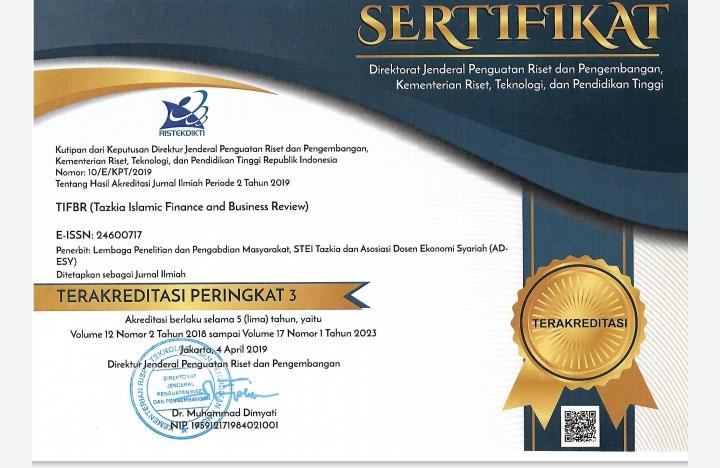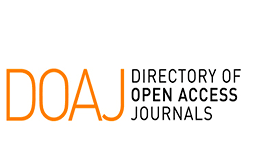GCG, ROE and Size on CSR Based on Sharia Enterprises Theory
DOI:
https://doi.org/10.30993/tifbr.v12i1.131Keywords:
Sharia Enterprise Theory, CSR, GCG, ROE, sizeAbstract
The purposes of this paper are to investigate the Corporate Social Responsibility (CSR) reporting information at Indonesia sharia banks based on Sharia Enterprise Theory and explores the potential effects of Corporate Governance (CG) elements, Return on Equity (ROE) on CSR based on sharia enterprises theory, with size as the moderating variable. Using the sample of 10 sharia banks which published annual reports, CG, and CSR reports above the year 2014 to 2016, the panel data are examined by regression. The statistic test reveals that size is not fit as a moderating variable in testing the effect of CG and ROE on CSR. Aggregately, GCG, Size and ROE influence CSR. A large and high-profit sharia bank which apply good corporate governance will implement CSR by considering horizontal and vertical accountability based on Sharia Enterprise theory. This study makes a significant contribution to the Corporate Social Responsibility (CSR) and enterprise theory by offering Sharia Enterprise theory as the foundation of the CSR implementation at sharia banks.
References
Badjuri, A. (2011). Faktor-Faktor Fundamental, Mekanisme Coorporate Governance, Pengungkapan Coorporate Social Responsibility (CSR) Perusahaan Manufaktur Dan Sumber Daya Alam Di Indonesia. Dinamika Keuangan dan Perbankan, Vol. 3(1): 38 - 54.
Benomran, N., et al. (2015). Influence of Corporate Governance on the Extent of Corporate Social Responsibility and Environmental Reporting. Journal of Environment and Ecology, Vol. 6(1): 48-68.
Blombäck, A., and Wigren, C. (2008). Challenging the Importance of Size as Determinant for CSR Activities. Management of Environmental Quality: An International Journal, Vol. 20(3): 255 – 270.
Chintrakarn, P., et al. (2016). The Effect of Corporate Governance on Corporate Social Responsibility. Journal of Financial Studies, Vol. 45(1).
Dewi, U. I., and Rahmawati. (2010). Pengaruh Ukuran Perusahaan, Ukuran Dewan Komisaris, Kepemilikan Institusional, Kepemilikan Asing, dan Umur Perusahaan terhadap Corporate Social Responsibility Disclousure pada Perusahaan Property dan Real Estate yang Terdaftar di Bursa Efek Indonesia. Jurnal Akuntansi dan Manajemen, Vol. 21(3): 297-306.
Ebiringa, O. T., et al. (2013). Effect of Firm Size and Profitability on Corporate Social Disclosures: The Nigerian Oil and Gas sector in Focus. British Journal of Economics, Management and Trade, Vol. 3(4): 563-574.
Erwanda, E., and Mulawarman, A. D. (2012). Tanggung Jawab Sosial Pada Organisasi Perbankan Syariah (Studi Kasus Pada Bni Syariah Cabang Malang). Jurnal Ilmiah FEB, Universitas Brawijaya, Vol. 1 (2).
Farook, S., Hassan, M. K., and Lanis, R. (2011). Determinants of Corporate Social Responsibility Disclosure: The Case of Islamic Banks. Journal of Islamic Accounting and Business Research, Vol. 2(2): 114-141.
Farook, S., and Lanis, R. (2007). Banking on Islam? Determinants of Corporate Social Responsibility Disclosure. School of Accounting. University of Technology, Sydney.
Farooq, S. U., Ullah, S., and Kimani, D. (2015). The Relationship between Corporate Governance and Corporate Social Responsibility (CSR) Disclosure: Evidence from the USA. Abasyn Journal of Social Sciences, Vol. 8(2): 197-212.
Furtado, T., Araújo, R., and Moreira, R. d. L. (2016). Relationship Between Corporate Governance And Corporate Social Responsibility Disclosure In Brazilian Companies. Paper presented at the XXI Congreso Internacional de Contaduria, Administracion E Informatica.
Harjoto, M., and Garen, J. (2005). Inside Ownership Beyond The IPO: The Evolution of Corporate Ownership Concentration. Journal of Corporate Finance, Vol. 11(4): 661-679.
Hussainey, K., Elsayed, M., and Razik, M. A. (2011). Factors Affecting Corporate Social Responsibility Disclosure In Egypt. Corporate Ownership and Control, Vol. 8(4).
Jensen, M. C., and Meckling, W. H. (1976). Theory of The Firm: Managerial Behavior, Agency Costs and Ownership Structure. Journal of Financial Economics, Vol. 3(4): 305-360.
Jo, H., and Harjoto, M. A. (2011). Corporate Governance and Firm Value: The Impact of Corporate Social Responsibility. Journal of Business Ethics, Vol. 103: 351-383.
Khan, A., Muttakin, M. B., and Siddiqui, J. (2013). Corporate Governance and Corporate Social Responsibility Disclosures: Evidence from an Emerging Economy. Journal Business Ethics, Vol. 114: 207-223.
Lindblom, C. K. (1994). The Implications of Organizational Legitimacy for Corporate Social Performance and Disclosure. Paper presented at the Critical Perspectives on Accounting Conference, New York.
Maali, B., Casson, P., and Napier, C. (2006). Social Reporting by Islamic Banks. Abacus, Vol. 42 (2).
Mackenzie, C. (2007). Boards, Incentives and Corporate Responsibility: The Case for a Change of Emphasis. Corporate Governance. An International Review, Vol. 15: 935-943.
Mansur, S. (2012). Pelaporan Corporate Social Responsibility Perbankan Syariah dalam Perspektif Syariah Enterprise Theory (Studi Kasus pada Laporan Tahunan PT Syariah Mandiri). Universitas Hasanuddin, Makasar.
Maryanti, E., and Tjahjadi, B. (2013). Analisis Corporate Social Responsibility dan Good Corporate Governance Terhadap Kinerja Keuangan yang Mempengaruhi Nilai Perusahaan Manufaktur yang Terdaftar di Bursa Efek Indonesia. Jurnal Ekonomi dan Bisnis, Tahun XXIII, (1): 47-62.
Meutia, I. (2009). Shari'ah Enterprise Theory Sebagai Dasar Pengungkapan Tanggungjawab Sosial Bank Syariah. Universitas Brawijaya Malang.
Meutia, I., and Febrianti, D. (2017). Islamic Social Reporting in Islamic Banking: Stakeholders Theory Perspective. Paper presented at the SHS Web of Conferences 34.
Mousa, G. A., and Hassan, N. T. (2015). Legitimacy Theory and Environmental Practices: Short Notes. International Journal of Business and Statistical Analysis, Vol. 2(1).
Mozghovyi, Y., and Ratnykova, I. (2011). Correlation Between The Corporate Social Responsibility and Financial Perfomance of The Bank in Ukrainian Context. Paper presented at The Second Annual Online International Conference on Corporate Governance and Regulation in Banks, Sumy, Ukraine.
Nawaiseh, M. E. (2015). Do Firm Size and Financial Performance Affect Corporate Social Responsibility Disclosure: Employees’ and Environmental Dimensions? American Journal of Applied Sciences, Vol. 12(12): 967-981.
Novianti. (2017). Pengaruh Good Corporate Governance dan Profitabilitas Terhadap Pengungkapan Corporate Social Responsibility (Studi pada Perusahaan S Ektor Pertambangan Peserta CGPI ( Corporate Governance Perception Index ) yang Terdaftar di Bursa Efek Indonesia Periode 2009 - 2016). Universitas Pasundan Bandung.
Petra, S. T. (2005). Do Outside Independent Directors Strengthen Corporate Boards. Corporate Governance, Vol 5(1): 55-64.
Trencansky, D., and Tsaparlidis, D. (2014). The Effects of Company´s Age, Size and Type of Industry on The Level of CSR : The Development of a New Scale for Measurement of The Level of CSR. (master), Umeå univesity.
Triyuwono, I. (2007). Mengangkat ”Sing Liyan” untuk Formulasi Nilai Tambah Syari‟ah. Paper presented at the Simposium Nasional Akuntansi X Universitas Hasanudin, Makasar.
Wiroso. (2009). Produk Perbankan Syariah. Jakarta: LPFE Usakti.
Downloads
Published
How to Cite
Issue
Section
License

Tazkia Islamic Finance and Business Review (TIFBR) is licensed under a Creative Commons Attribution-NonCommercial 4.0 International License.
Authors who publish with this journal agree to the following terms:
- Authors retain copyright and grant the journal right of first publication with the work simultaneously licensed under a Creative Commons Attribution License that allows others to share the work with an acknowledgment of the work's authorship and initial publication in this journal.
- Authors are able to enter into separate, additional contractual arrangements for the non-exclusive distribution of the journal's published version of the work (e.g., post it to an institutional repository or publish it in a book), with an acknowledgment of its initial publication in this journal.
- Authors are permitted and encouraged to post their work online (e.g., in institutional repositories or on their website), as it can lead to productive exchanges, as well as earlier and greater citation of published work (See the Effect of Open Access).
















